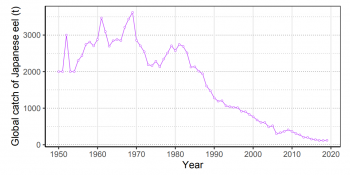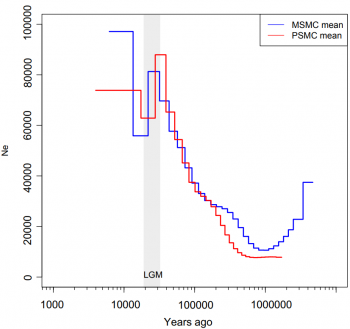【2022.6.6】
Grilled Japanese eel (蒲焼) is an iconic delicacy that is traditionally eaten during summer, especially on doyou-no ushi-no-hi (土用の丑の日), to boost stamina in the hot and humid weather. However, in recent years the cost of Japanese eel dishes has increased considerably because the number of eels caught in the wild and grown in aquaculture has decreased. In fact, only 11.1 tons of eel were caught in Japan in 2021, compared to approximately 3000 tons in the 1970s. This pattern indicates that the overall population size of Japanese eel has also greatly decreased. Indeed, Japanese eel is now listed as an endangered species by the IUCN. Researchers at Nagano University’s Institute of Freshwater Biology, in collaboration with the Japanese Fisheries Agency, have been conducting genomic analyses to determine changes in the past population size of Japanese eel. By investigating historical changes in the population size of Japanese eel it is possible to gain a better understanding of current population dynamics. This research was recently published in the international journal, Aquatic Conservation: Marine and Freshwater Ecosystems (https://onlinelibrary.wiley.com/doi/10.1002/aqc.3810).
Grilled Japanese eel (蒲焼) is an iconic delicacy that is traditionally eaten during summer, especially on doyou-no ushi-no-hi (土用の丑の日), to boost stamina in the hot and humid weather. However, in recent years the cost of Japanese eel dishes has increased considerably because the number of eels caught in the wild and grown in aquaculture has decreased. In fact, only 11.1 tons of eel were caught in Japan in 2021, compared to approximately 3000 tons in the 1970s. This pattern indicates that the overall population size of Japanese eel has also greatly decreased. Indeed, Japanese eel is now listed as an endangered species by the IUCN. Researchers at Nagano University’s Institute of Freshwater Biology, in collaboration with the Japanese Fisheries Agency, have been conducting genomic analyses to determine changes in the past population size of Japanese eel. By investigating historical changes in the population size of Japanese eel it is possible to gain a better understanding of current population dynamics. This research was recently published in the international journal, Aquatic Conservation: Marine and Freshwater Ecosystems (https://onlinelibrary.wiley.com/doi/10.1002/aqc.3810).

The results of this study suggest that Japanese eel experienced a reduction in population size during the Pliocene (1-4 million years ago), steadily increased in population size from 1 Ma up until approximately 22-30 kya, during which time a population bottleneck – a sudden decrease in population size – occurred. These events were most likely caused by changes in riverine habitats as well as sea level and oceanic currents that restricted the Japanese eel’s natural reproductive process (drift of larvae and/or migration of adult fish). The reductions in population size experienced by Japanese eel may have contributed to their current overall low level of genetic diversity, which may make the species more sensitive to future population declines. Future climate change as well as the ongoing harvesting of Japanese eel are of concern to fisheries management agencies. To get a better understanding of the future population dynamics of Japanese eel, the data from this study will be incorporated into models of extinction risk.

The results of this study were presented at the 1st Scientific Meeting on Japanese Eel and Other Relevant Eels in April 2022. This meeting was hosted by Japan and attended by representatives from all Japanese eel range-states (China, South Korea, and Taiwan) as well as experts with experience in the management of European eel. The aim of the meeting was to share scientific knowledge and provide advice for the management of Japanese eel. Researchers from Nagano University’s Institute of Freshwater Biology highlighted the need to continue monitoring the population size of Japanese eel and enforce conservative catch limits. They also noted that it is essential to maintain the habitat and environmental conditions that facilitate the unique natural cycle of recruitment of Japanese eel. It is anticipated that the future co-operation of scientists from across the distributional range of Japanese eel will help ensure the long-term sustainable management of Japanese eel.






